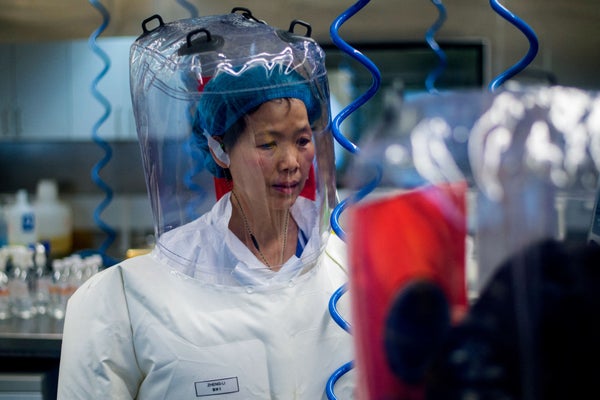December 6, 2024
3 min study
Wuhan Virologist Says Lab Has No Shut Household to COVID Virus
Shi Zhengli, a virologist on the Coronary heart for COVID-19 lab-leak concept, revealed the coronavirus sequences from the Wuhan Institute

Chinese language language virologist Shi Zhengli has launched proof that her lab has not labored with shut relations of SARS-CoV-2.
Johannes Eisele/AFP by way of Getty Images
After years of rumours that the virus that causes COVID-19 escaped from a laboratory in China, the virologist on the centre of the claims has launched information on dozens of newest coronaviruses collected from bats in southern China. At a conference in Japan this week, Shi Zhengli, a specialist on bat coronaviruses, reported that not one of many viruses saved in her freezers are the newest ancestors of the virus SARS-CoV-2.
Shi was primary coronavirus evaluation on the Wuhan Institute of Virology (WIV), a high-level biosafety laboratory, when the first cases of COVID-19 have been reported in that metropolis. Shortly afterwards, theories emerged that the virus had leaked — each by chance or deliberately — from the WIV.
Shi has persistently talked about that SARS-CoV-2 was certainly not seen or studied in her lab. Nonetheless some commentators have continued to ask whether or not or not one in every of many many bat coronaviruses her group collected in southern China over a few years was intently related to it. Shi promised to sequence the genomes of the coronaviruses and launch the information.
On supporting science journalism
In case you are having enjoyable with this textual content, take into consideration supporting our award-winning journalism by subscribing. By shopping for a subscription you are serving to to ensure the way in which ahead for impactful tales in regards to the discoveries and ideas shaping our world proper this second.
The latest analysis, which has not been peer reviewed, incorporates information from the whole genomes of 56 new betacoronaviruses, the broad group to which SARS-CoV-2 belongs, along with some partial sequences. All the viruses have been collected between 2004 and 2021.
“We didn’t uncover any new sequences which might be further intently related to SARS-CoV-1 and SARS-CoV-2,” talked about Shi, in a pre-recorded presentation on the conference, Preparing for the Subsequent Pandemic: Evolution, Pathogenesis and Virology of Coronaviruses, in Awaji, Japan, on 4 December. Earlier this 12 months, Shi moved from the WIV to the Guangzhou Laboratory, a newly established nationwide evaluation institute for infectious diseases.
The outcomes help her assertion that the WIV lab did not have any bat-derived sequences from viruses which have been further intently related to SARS-CoV-2 than have been any already described in scientific papers, says Jonathan Pekar, an evolutionary biologist on the School of Edinburgh, UK. “This merely validates what she was saying: that she did not have one thing terribly intently related, as we’ve seen throughout the years since,” he says.
The closest acknowledged viruses to SARS-CoV-2 have been current in bats in Laos and Yunnan, southern China — nonetheless years, if not a few years, have handed since they break up from their widespread ancestor with the virus that causes COVID-19. “She’s primarily found various what we depend on,” says Leo Poon, a virologist on the School of Hong Kong.
Longtime collaboration
For a few years, Shi collaborated with Peter Daszakpresident of the EcoHealth Alliance, a New York Metropolis-based non-profit group, to survey bats in southern China for coronaviruses and analysis their menace to individuals. The work was funded by the US Nationwide Institutes of Nicely being and the US Firm for Worldwide Enchancment, nonetheless in Would possibly this 12 months, the authorities suspended federal funding to EcoHealth because of it had not provided sufficient oversight of study actions on the WIV. These actions included modifying a coronavirus linked to excessive acute respiratory syndrome (SARS), to verify the potential origins of this type of virus in bats.
Over time, the collaboration between Shi and Daszak collected larger than 15,000 swabs from bats throughout the space. The group examined these for coronaviruses, and re-sequenced the genomes of people that examined optimistic. The gathering expands the acknowledged number of coronaviruses. “She found sequences which will on the very least current further context to our understanding of coronaviruses,” says Pekar.
In an even bigger analysis of 233 sequences — along with the model new sequences and some that had beforehand been printed — Shi and her colleagues acknowledged 7 broad lineages and proof of viruses extensively swapping chunks of RNA, a course of typically known as recombination. Daszak says the analysis moreover assesses the hazard of these viruses leaping to people and identifies potential drug targets; “data of direct price to public properly being”.
Daszak says the group has expert delays in submitting the work for peer overview, owing to funding cuts, challenges working all through areas and quite a few US authorities investigations of EcoHealth. Nonetheless, the researchers plan to submit the analysis to a journal throughout the subsequent few weeks.
This textual content is reproduced with permission and was first printed on December 6, 2024.












Leave a Reply